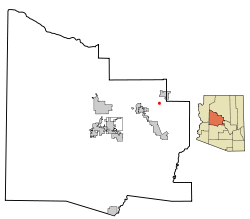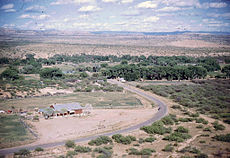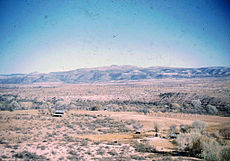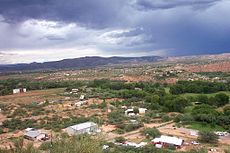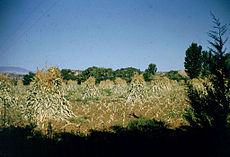- Cornville, Arizona
-
Cornville, Arizona — CDP — Location in Yavapai County and the state of Arizona Coordinates: 34°42′58″N 111°54′36″W / 34.71611°N 111.91°WCoordinates: 34°42′58″N 111°54′36″W / 34.71611°N 111.91°W Country United States State Arizona County Yavapai Area – Total 13.2 sq mi (34.2 km2) – Land 13.2 sq mi (34.3 km2) – Water 0.0 sq mi (0.0 km2) Elevation 3,225 ft (983 m) Population (2000) – Total 3,335 – Density 252.1/sq mi (97.3/km2) Time zone MST (UTC-7) ZIP code 86325 Area code(s) 928 FIPS code 04-15920 GNIS feature ID 0027961 Cornville is a census-designated place (CDP) in Yavapai County, Arizona, United States. The population was 3,335 at the 2000 census. The Cornville CDP includes the communities of Cornville and Page Springs.
Cornville and Page Springs are rapidly-growing suburban areas that serve as bedroom communities for nearby Sedona and Cottonwood, Arizona. Both communities are located along scenic Oak Creek, a tributary of the Verde River. Lower Oak Creek has been designated an Important Bird Area by the National Audubon Society. Page Springs hosts the large Page Springs fish hatchery, operated by Arizona Game and Fish. Adjacent to the hatchery are creekside hiking trails and bird-watching areas.
Cornville's best known resident is U.S. Senator and 2008 Republican Presidential candidate John McCain. McCain's home in the community, referred to in the media as his "Sedona Cabin," is where he and his running-mate, Alaska governor Sarah Palin, prepared for their debates.
Cornville has a Greater Cornville Community Association [1] which meets monthly.
Contents
History
The Cornville area, particularly above and below the Cornville Bridge on Oak Creek, was well settled by the Sinagua. The Sinagua had disappeared from the abandoned buildings at nearby Montezuma Castle National Monument by the early 15th century. Some Hopi clans claim descent from these Sinagua.
The earliest recorded written history of the area finds it occupied by the Yavapai people. Spanish explorer Antonio de Espejo passed through what is now Cornville on May 7 or 8, 1583 on his way to what would later become Jerome, Arizona. The Yavapai were quite friendly with the explorers, apparently regarding them as supernatural or godlike. Later expeditions over the next 25 years entered the region but with increasing hostility from the native American peoples which may stem in part from the advent of the Apache and Navajo people in the region. Failure to find mineral resources profitably extractable according to the standards of the day, and the distance from other Spanish settlements caused the Spaniards to cease exploration of the area.[1] By the time the Mountain Men began to arrive in the late 1820s and settlers began to arrive again in the 1860s the people of the Cornville area were a mixed community of Apache (Dil-ze'e) and Yavapai (Wipukepaya), though the Apache are thought to have been more numerous on the east side of the Verde River. The area that is now lower Oak Creek was more or less on the border of the area occupied by the Dil-ze'e Chein-chii-ii (or Red Rock Clan) and Yaa-go-gain (White Land Clan) [2] The US army gathered the Yavapai and Apache people in the area and in 1875 removed them in a tragic and brutal march and exile to the San Carlos Reservation in Eastern Arizona,[2] but many Dilze'e remained in hiding in the Lower Oak Creek and adjoining White Hills area [3] As late as 1876, numerous Dil-ze'e still lived on or near Lower Oak Creek.[4] Relations between settlers and indigenous peoples in the Verde Valley were essentially peaceful from that point on and with the rapid increase in settlers along Oak Creek, although there were "Indian scares" into the 1880s mostly in connection with conflicts elswhere: In the words of settler W. A. Jordan, in about 1880 "The settlers were in no danger from this band of hunters [that he had just met between Clarkdale and Cornville], but they were so wrought up over the stories of massacres and murders that the Indians themselves were in the greatest danger." [5] There was resistance among part though not all of the settler population to ending the prohibition on the return or the Dil-ze'e and Yavapai from San Carlos. Most remaining or Dil-ze'e and Yavapai lost hope of abiding peacefully and unmolested amidst increasing numbers of settlers and left to join returnees from the San Carlos Reservation in nearby communities in Camp Verde and Clarkdale. They did continue for many years to hunt throughout the valley [5] and to gather food in the traditional ways [6]
The first settlers in the Lower Oak Creek area were Captain Andrew Jackson, a retired Confederate officer from Virginia, and his wife, Margaret, who arrived in the spring of 1876.[4] Several other families including the Dickinsons,[7] Munds,[8] Copples, Pages [9] Mullhollands and Tiptons had followed by the autumn of that year or the spring of 1877.[10] The settlers quickly built an irrigation ditch serving farms on the west side of Oak Creek.
As to the adoption of the name of "Cornville", "At a meeting of Verde Valley pioneers, one of them said it was the intention to name it Cohnville, for a family named Cohn that lived there. When the papers came back from Washington, they had read it Cornville, so the settlers accepted the name." --Letter, L.J. Putsch, early Forest Ranger.[11] However, there was no family name Cohn or Kohn in the Cornville area in 1880 according to the United States Census of 1880.[12] However, there was a Mr. Cone who together with his partner a Mr. Houghton had purchased a proved homestead in what is now Page Springs from Benjamin Coppel in 1878, farmed a year and then rented the property to a family from Arkansas. Both Mr. Cone and Mr. Houghton sold their interests in the ranch to James Page in about 1880.[13] The Cornville post office was established May 11, 1887 and Samuel Dickinson was postmaster until 1907 and it is therefore likely was the one who made application for the name "Cornville" for whatever reason.[14] With the decline in the profitability of cattle and the Great Depression, much of Cornville was reduced to subsistence or near subsistence agriculture in the first half of 20th century though some families ranched the surrounding grazing lands while others went to work in the mines and smelters of Jerome, Clarkdale and Cottonwood when work was available. The town remained almost entirely agricultural until the late 1960s when numbers of retirees and residents who commute to work in nearby towns began to increase dramatically.
The community of Verde Santa Fe was founded in 1995. It is a home golf course community located in Cornville, along State Route 89A, between Cottonwood and Sedona. The community consists of nearly 1,000 homes in ten subdivisions.[15][16]
In addition to Senator McCain, other notable residents of the area over the years have included rancher Frank Gyberg, sculptor John Henry Waddell and the late St Louis Rams owner Georgia Frontiere.
Geography
Cornville is located at 34°42′58″N 111°54′36″W / 34.71611°N 111.91°W (34.716202, -111.909905).[17]
According to the United States Census Bureau, the CDP has a total area of 13.2 square miles (34 km2), all of it land.
Demographics
As of the census[18] of 2000, there were 3,335 people, 1,311 households, and 895 families residing in the CDP. The population density was 252.1 people per square mile (97.3/km²). There were 1,441 housing units at an average density of 108.9/sq mi (42.1/km²). The racial makeup of the CDP was 93.22% White, 0.39% Black or African American, 0.84% Native American, 0.60% Asian, 0.06% Pacific Islander, 2.70% from other races, and 2.19% from two or more races. 9.12% of the population were Hispanic or Latino of any race.
There were 1,311 households out of which 28.7% had children under the age of 18 living with them, 54.2% were married couples living together, 8.9% had a female householder with no husband present, and 31.7% were non-families. 23.6% of all households were made up of individuals and 6.6% had someone living alone who was 65 years of age or older. The average household size was 2.47 and the average family size was 2.89.
In the CDP the population was spread out with 24.5% under the age of 18, 6.2% from 18 to 24, 25.9% from 25 to 44, 30.0% from 45 to 64, and 13.4% who were 65 years of age or older. The median age was 41 years. For every 100 females there were 101.5 males. For every 100 females age 18 and over, there were 96.9 males.
The median income for a household in the CDP was $36,992, and the median income for a family was $42,333. Males had a median income of $31,567 versus $21,653 for females. The per capita income for the CDP was $16,500. About 11.0% of families and 15.9% of the population were below the poverty line, including 19.5% of those under age 18 and 8.7% of those age 65 or over.
Attractions
Eliphante [2], "three acres of fantastical domes, shacks and follies"[19] created over 28 years by Michael Kahn and his wife, Leda Livant, is a little-known attraction in Cornville. Eliphante may be visited by appointment or during special events.
Notable residents
- Tool, A Perfect Circle, and Puscifer vocalist Maynard James Keenan is a current resident.
- Senator John McCain has a vacation home on Oak Creek, near Page Springs.[20]
- Sculptor John Henry Waddell had a studio in Cornville during the 1980s.
- St. Louis Rams owner Georgia Frontiere had a residence in Cornville.
Notes
- ^ Byrkit, 1984, p. 1.
- ^ a b Ruland-Thorne, 1993. pp. 11-12.
- ^ Simmons, 1983. p. 75.
- ^ a b Dumas, 1975, p. 188.
- ^ a b Jordan, 1954, pp.101-102.
- ^ Coder, Randall, Smith-Roca & Hines
- ^ Fain, 1954, p. 68.
- ^ BLM Records On-line
- ^ , Page, 1954, p. 24.
- ^ Lay, 1954, p. 67.
- ^ L.J. Putsch, quoted at http://jeff.scott.tripod.com/cornville.html (accessed 5/25/07)
- ^ US Federal census for Arizona, 1800
- ^ Godard et al., 1954, p. 24.
- ^ Fain, 1954, p. 68
- ^ http://www.verdesantafe.com/course.html
- ^ http://www.vsfneighbors.com
- ^ "US Gazetteer files: 2010, 2000, and 1990". United States Census Bureau. 2011-02-12. http://www.census.gov/geo/www/gazetteer/gazette.html. Retrieved 2011-04-23.
- ^ "American FactFinder". United States Census Bureau. http://factfinder.census.gov. Retrieved 2008-01-31.
- ^ A Handmade Home - New York Times
- ^ Arizona's Cornville could be the next President's retreat
Further reading
- Bureau of Land Management On Line Land Records, Land Patent Details, for Munds in Yavapai County: http://www.glorecords.blm.gov/PatentSearch/Detail.asp?PatentDocClassCode=SER&Accession=AZAZAA+014874&Index=3&QryID=8243.93&DetailTab=1
- Dr. James Byrkit, "Antonio de Espejo's Expedition to Jerome, Arizona May, 1583" in COTTONWOOD, CLARKDALE AND CORNVILLE HISTORY, edited by Isabel J. Simmons, (published by) the American Association of Retired Persons(1985)
- Coder, RAndall, Smith Roca & Hines. CHI CH’ IL (Acorns): Dissolution of Traditional
Dilzhe’e Gathering Practice(s) Due to Federal Control of the Landscape http://www.fs.fed.us/rm/pubs/rmrs_p036/rmrs_p036_277_281.pdf
- Fain, Mildred, "Old Timers" in PIONEER STORIES OF ARIZONA'S VERDE VALLEY, edited by Jesse Goddard, Samuel Benedict and Pauline Boyer, (published by) the Verde Valley Pioneers Association (1954)
- Lenore Dumas, "A Remarkable Woman of the Early West" In THOSE EARLY DAYS: OLDTIMERS MEMOIRS OAK CREEK - SEDONA AND THE VERDE VALLEY REGION OF NORTHERN ARIZONA, (published by) The Sedona
Westerners (1975)
- W. A. Jordan, REminiscences of W. A. Jordan, "My only Indian Scare" in PIONEER STORIES OF ARIZONA'S VERDE VALLEY, edited by Jesse Goddard, Samuel Benedict and Pauline Boyer, (published by) the Verde Valley Pioneers Association (1954)
- Inez Lay, "Samuel Loy and His Neighbors of 1877" in PIONEER STORIES OF ARIZONA'S VERDE VALLEY, edited by Jesse Goddard, Samuel Benedict and Pauline Boyer, (published by) the Verde Valley Pioneers Association (1954)
- United States Federal Census for Arizona 1880 Yavapai County, District 28 pp. 1–5.
- James Page, "Pioneering" in PIONEER STORIES OF ARIZONA'S VERDE VALLEY, edited by Jesse Goddard, Samuel Benedict and Pauline Boyer (published by) the Verde Valley Pioneers Association (1954)
- Kate Ruland-Thorne, The Yavapai: Sedona's Native People, Thorne Enterprises 1993
- Isabel J. Simmons "Interview of Vincent Randall and Lulu Randall" in in COTTONWOOD, CLARKDALE AND CORNVILLE HISTORY, edited by Isabel J. Simmons, (published by) the American Association of Retired Persons(1985)
External links
- Cornville, Arizona
- Page Springs, Arizona
- Eliphante
- Eliphante slide show
- Lower Oak Creek Important Bird Area, at Audubon
Municipalities and communities of Yavapai County, Arizona Cities Cottonwood | Peoria‡ | Prescott | Sedona‡
Towns CDPs Ash Fork | Bagdad | Big Park | Black Canyon City | Congress | Cordes Lakes | Cornville | Lake Montezuma | Mayer | Paulden | Peeples Valley | Seligman | Spring Valley | Verde Village | Wilhoit | Williamson | Yarnell
Unincorporated
communitiesCherry | Cleator | Crown King | Drake | Iron Springs | Kirkland | Red Rock | Skull Valley
Indian reservation Hualapai Indian Reservation
Ghost towns Alexandra | Big Bug | Bradshaw City | Bumble Bee | Catoctin | Cordes | Jerome Junction | Octave | Piedmont | Stanton | Tip Top | Weaver
Footnotes ‡This populated place also has portions in an adjacent county or counties
Categories:- Census-designated places in Yavapai County, Arizona
Wikimedia Foundation. 2010.

